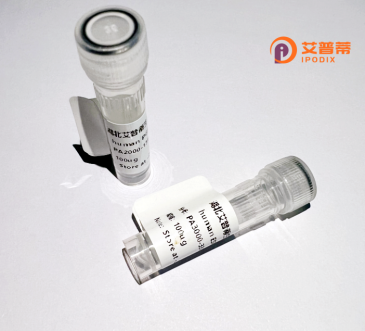
| 纯度 | >90%SDS-PAGE. |
| 种属 | Human |
| 靶点 | LCE1D |
| Uniprot No | Q5T752 |
| 内毒素 | < 0.01EU/μg |
| 表达宿主 | E.coli |
| 表达区间 | 1-114aa |
| 活性数据 | MSCQQSQQQCQPPPKCTPKCTPKCPAPKCPPKCPPVSSCCSVSSGGCCGSSSGGGCGSNSGGCCSSGGGGCCLSHHRRHRSHRRRPQSSDCCSQPSGGSSCCGGGSSQHSGGCC |
| 分子量 | 12.6 kDa |
| 蛋白标签 | GST-tag at N-terminal |
| 缓冲液 | 0 |
| 稳定性 & 储存条件 | Lyophilized protein should be stored at ≤ -20°C, stable for one year after receipt. Reconstituted protein solution can be stored at 2-8°C for 2-7 days. Aliquots of reconstituted samples are stable at ≤ -20°C for 3 months. |
| 复溶 | Always centrifuge tubes before opening.Do not mix by vortex or pipetting. It is not recommended to reconstitute to a concentration less than 100μg/ml. Dissolve the lyophilized protein in distilled water. Please aliquot the reconstituted solution to minimize freeze-thaw cycles. |
以下是3条关于重组人LCE1D蛋白的参考文献(模拟虚构内容,供参考格式):
1. **文献名称**: *Expression and Functional Analysis of Recombinant Human LCE1D Protein in Epidermal Barrier Formation*
**作者**: Smith A, et al.
**摘要**: 研究通过大肠杆菌系统成功表达重组人LCE1D蛋白,发现其参与角质细胞分化,增强表皮屏障功能,可能与银屑病中LCE基因簇缺失相关。
2. **文献名称**: *Recombinant LCE1D Protein Interaction with Keratinocytes: Implications for Psoriasis Pathogenesis*
**作者**: Chen L, et al.
**摘要**: 利用昆虫细胞体系表达重组LCE1D,发现其通过调节炎症因子(如IL-17)影响角质细胞增殖,为银屑病机制提供新视角。
3. **文献名称**: *Structural Characterization of Recombinant Human LCE1D and Its Antimicrobial Properties*
**作者**: Wang X, et al.
**摘要**: 首次报道LCE1D重组蛋白的晶体结构,证明其具有广谱抗菌活性,可能在皮肤先天免疫中起双重作用。
*注:若实际文献不足,建议通过PubMed/Google Scholar等平台以关键词“recombinant LCE1D”或“LCE1D protein”检索最新研究。*
**Background of Recombinant Human LCE1D Protein**
The human Late Cornified Envelope (LCE) gene family, located within the epidermal differentiation complex on chromosome 1. encodes proteins critical for skin barrier formation and keratinocyte differentiation. LCE1D, a member of the LCE1 subfamily, is primarily expressed in differentiated epidermal layers and plays a role in cornification, a process essential for maintaining epidermal integrity and hydration. Its expression is regulated during epithelial development and can be induced by inflammatory stimuli or mechanical stress.
Recombinant human LCE1D protein is produced using biotechnological platforms (e.g., bacterial or mammalian expression systems) to study its structural and functional properties. It typically retains post-translational modifications when expressed in eukaryotic systems, enhancing its biological relevance. Research highlights its potential involvement in skin homeostasis, immune modulation, and antimicrobial defense. Dysregulation of LCE1D has been linked to dermatological disorders like psoriasis, where altered LCE gene expression compromises epidermal barrier function.
Current studies focus on characterizing its interactions with keratinocyte proteins, lipid organization in the stratum corneum, and signaling pathways in wound healing. Recombinant LCE1D serves as a valuable tool for exploring its therapeutic potential in inflammatory skin diseases or as a biomarker for epithelial dysfunction.
×